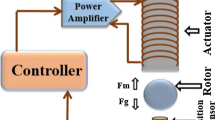Abstract
Electromagnets are widely used as driving devices in industry. In this article, we describe various designs and methods of analysis for a built-in coil electromagnetic holding device based on three main design characteristics: volume, applied voltage, and suction force. Our aim is to achieve greater suction force or Gaussian value without changing the external dimensions of the frame, by varying the magnetic pole surface area, the thickness of the iron frame, and/or the electromagnetic material. We verify the design with the simulation software ANSYS Maxwell, which uses a commercial finite element method, to find the best design parameters to maximize the suction force or Gaussian value. The experimental results confirm the results of our simulation studies and demonstrate that simulations can achieve substantial reductions in cost and time over traditional trial-and-error methods. Furthermore, the experimental results indicate that electromagnetic products with bigger pole surface areas provide more suction force than electromagnetic products with smaller pole surface areas only when the applied voltage is less than 9 V. Above 9 V, smaller pole surface areas definitely result in bigger suction force.























Similar content being viewed by others
References
Alizadeh HV, Boulet B (2016) Analytical calculation of the magnetic vector potential of an axisymmetric solenoid in the presence of iron parts. IEEE Trans Magn 52:8201104
Duchaud J-L, Hlioui S, Louf F, Ojeda J, Gabsi M (2015) Modeling and optimization of a linear actuator for a two-stage valve tappet in an automotive engine. IEEE Trans Veh Technol 64:4441–4448
Han DK, Chang JH (2016) Design of electromagnetic linear actuator using the equivalent magnetic circuit method. IEEE Trans Magn. https://doi.org/10.1109/tmag.2015.2498198
Kim J, Chang J (2007) A new electromagnetic linear actuator for quick latching. IEEE Trans Magn 43:1849–1852
Li C, Yang H, Jenkins LL, Dean RN, Flowers GT, Hung JY (2016) Enhanced-performance control of an electromagnetic solenoid system using a digital controller. IEEE Trans Control Syst Technol 24:1805–1811
Liu Q, Bo H, Qin B (2010) Experimental study and numerical analysis on electromagnetic force of direct action solenoid valve. Nucl Eng Des 240:4031–4036
Liu C-T, Chiu Y-W, Hwang C-C (2016) Designs and feasibility assessments of an integrated linear electromagnetic actuator for cold roll mill applications. IEEE Trans Ind Appl 52:2693–2699
Mansfield AN (2006) Electromagnets: their design and construction. Watchmaker Publishing, Washington. ISBN 9781933998053
Mercorelli P, Lehmann K, Liu S, Muamer H, Reimann B (2003) Control of an electromagnetic linear actuator using flatness property and systems Inversion. In: 2003 European control conference (ECC), Cambridge, UK, 1–4 Sept., 2003
Sun Z-Y, Li G-X, Wang L, Wang W-H, Gao Q-X, Wang J (2016) Effects of structure parameters on the static electromagnetic characteristics of solenoid valve for an electronic unit pump. Energy Convers Manag 113:119–130
Wang L, Li G-X, Xu C-L, Xi X, Wu X-J, Sun S-P (2016) Effect of characteristic parameters on the magnetic properties of solenoid valve for high-pressure common rail diesel engine. Energy Convers Manag 127:656–666
Wu CH, Grant CV, Cook GA, Park SH, Opella SJ (2009) A strip-shield improves the efficiency of a solenoid coil in probes for high-field solid-state NMR of lossy biological samples. J Magn Reson 200:74–80. https://doi.org/10.1016/j.jmr.2009.06.004
Zheng J, Song Y, Liu X, Li L, Wan Y, Wan B, Ye M, Wu H (2015) Concept design of the CFETR central solenoid. Fusion Eng Des 91:30–38
Zhu J, Chang S (2012) Modeling and simulation for application of electromagnetic linear actuator direct drive electro-hydraulic servo system. In: 2012 IEEE international conference on power and energy (PECon), Kota Kinabalu Sabah, Malaysia, 2–5 December 2012
Author information
Authors and Affiliations
Corresponding author
Additional information
Publisher's Note
Springer Nature remains neutral with regard to jurisdictional claims in published maps and institutional affiliations.
Rights and permissions
About this article
Cite this article
Chen, CY., Wu, RC., Tsai, BJ. et al. Design and analysis of an electrical magnetic holding device. Microsyst Technol 27, 1019–1030 (2021). https://doi.org/10.1007/s00542-018-4007-y
Received:
Accepted:
Published:
Issue Date:
DOI: https://doi.org/10.1007/s00542-018-4007-y




